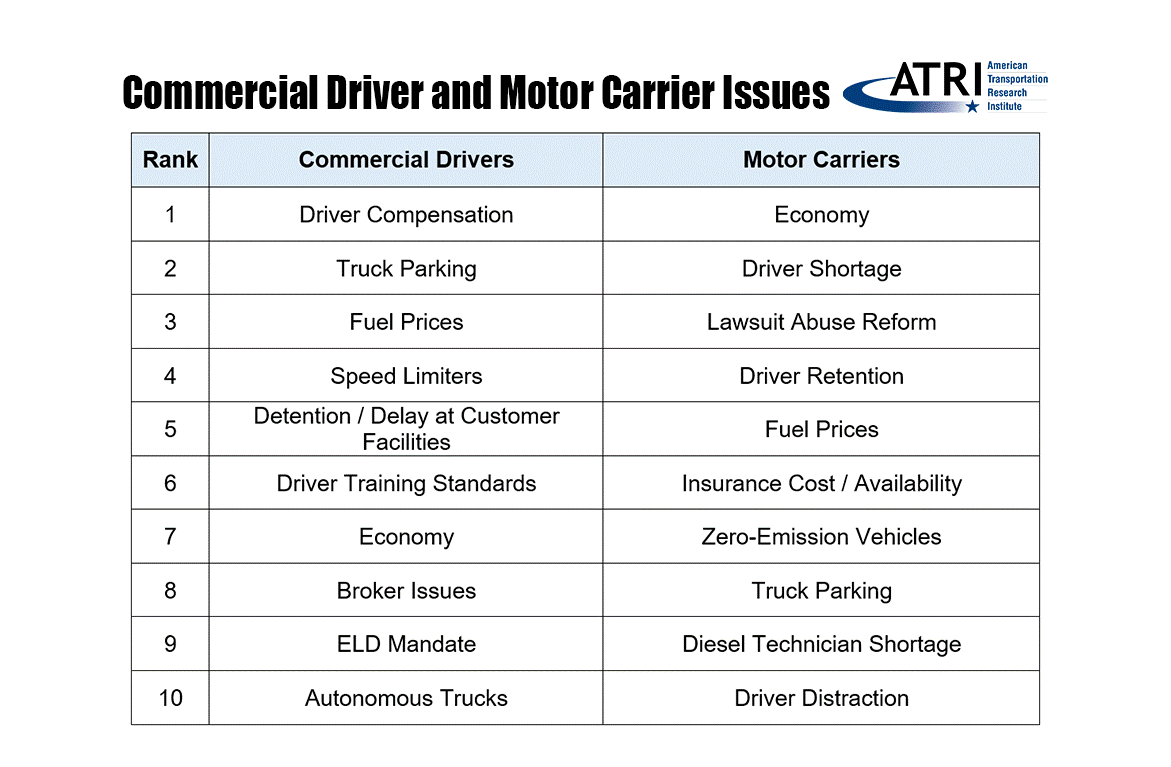Older Driver Safety Awareness Week
This week's safety bulletin discusses the importance of older driver safety and how to prepare for the time change. Read the full safety bulletin here and subscribe to receive future safety bulletins straight to your mailbox.
December 4-8 is Older Driver Safety Awareness Week
Between 2012 and 2021, the United States population of people 65 and older increased by 29%. In 2021, 7,489 people 65 and older were killed in traffic crashes in the United States, accounting for 17% of all traffic fatalities.
That's why the National Highway Transportation Safety Administration (NHTSA) is bringing attention to the safety of older drivers. The goal during Older Driver Safety Awareness Week and every week of the year is to raise awareness about more senior driver safety.
Click here to download campaign-earned media materials.
As we look into the future, the continued challenge of a driver shortage looms as a "perfect storm," and older drivers play an integral part. Many variables would have an impact on the deficit. One element of the driver shortage is an ageing workforce combined with a decline in the primary demographic group that comprises the bulk of the driver pool. As we see freight volumes increase, many fleets need help attracting qualified drivers and may be unable to seat trucks or add capacity at a time when freight volumes are growing. If current demographic trends continue, that shortage of truck drivers could increase to 111,000 by the end of the year. Over the next decade, the trucking industry must hire 890,000 new drivers, or an average of 89,000 annually. Replacing retiring truck drivers will be the most prominent factor, accounting for nearly half of new driver hires (45%). The second most significant element will be industry growth, accounting for 33% of new driver hires. As transportation managers, we see our driving workforce continue to age. The average age of a truck driver in the United States is over 50 years. Since 2000, the number of truck drivers 55 or older has surged 19% to about 616,000, according to the Federal Bureau of Labor Statistics. Truck companies with baby boomer drivers insist their safety record is at least as good as that of younger drivers.
We do not age at the same rate. The FMCSA does not have a maximum age limit for drivers of commercial motor vehicles, unlike that of the FAA concerning pilots. All drivers are subject to the medical qualifications of medical certification requirements of CFR 391.
But the question remains: how do we, as transportation managers, know when it is time to ask for the keys of a driver that is no longer able to operate safely?
Here are a few suggestions:
- Develop a proactive safety and loss control program with policies and procedures that are not biased to age.
- Require all drivers to have physical examinations completed by an FMCSA-registered medical examiner with a relationship to your company.
- Develop job descriptions and job requirements for all positions based on the physical needs of the job.
- Implement a defensive driver training program with updated training annually for all drivers.
- Administer structured check rides at least annually to all drivers to access the driver's skills and abilities.
- Develop a continuing relationship with all drivers to keep an open line of communication regarding their ability to complete their driving responsibilities safely.
- Be vigilant and observant of the actions of all drivers.
Time to Fall Back. Daylight Savings Time Changes this Sunday, November 5th!
Daylight savings time will "fall back" at 2:00 a.m. on Sunday, November 5th. Make sure that all your drivers are aware that the change to daylight savings will occur. Caution route drivers that the amount of daylight will change according to their stops with the change. An intersection or street can present different challenges to drivers with one one-hour change in the sun's position. One hour of time difference can present unique adaptations to a driver on a route.
Daylight Saving Time (DST) — not Daylight Savings Time — can have a significant impact on truck drivers. Shifting sleep schedules, logging considerations, and dealing with roads filled with fatigued drivers can all pose a challenge for truck drivers dealing with the time change.
When do I change my clocks?
Daylight Saving Time begins at 2 a.m. on Sunday, November 5th (and ends again at 2 a.m. on Sunday, March 10th, 2024). Every state aside from Arizona (except for the Navajo Nation) and Hawaii observes DST.
You should set your clocks one hour behind— fall back — before you go to bed Saturday night. While most devices automatically adjust for DST, you should double-check their settings. This is especially important if you rely on your phone as your alarm clock.
How do Electronic Logging Devices (ELDs) handle Daylight Saving Time?
E-logs (ELDs) are now federally mandated since 2017. Most e-log providers automatically handle the DST calculations for drivers.
Regardless of springing forward or falling back, drivers still need to adhere to the Department of Transportation (DOT) Federal Motor Carrier Safety Administration (FMCSA) Hours of Service (HOS) regulations of how many hours a truck driver can drive.
E-log DST examples:
If you work 1 a.m.-10 a.m., it should show you worked nine hours versus nine because you fell back one hour during that timeframe.
If you start your 10-hour break at 10 p.m. on Saturday, your 10 hours off duty usually end at 8 a.m. on Sunday. Because this is a DST day, though, you will complete your 10 hours at 7 a.m.
You must still take a complete 10-hour break and follow all HOS rules.
The same goes for the 34-hour restart. If the restart crosses over DST on Sunday, you will reach your 34 an hour earlier than expected.
You must still take a full 34-hour reset and follow all HOS rules.
How Daylight Saving Time can impact electronic logging devices:
The times for the duty status before daylight savings end will show a Daylight Time designation (EDT, CDT, etc.). Rates after the time change will appear under the Standard Time designation (EST, CST, etc.).
Since this is not a standard day, the time on your November 5th log will add up to 25 hours, regardless of what device you use.
For tablets with HOS functionality, your device will automatically fall back one hour at 2 a.m. of your regulatory home terminal time.
If you use paper logs, you must flag your log in the remarks section with "Fall Time Change."
Got Chains?
If you are operating in a state that requires chains to be on board, make sure the chains are the correct size, adequately secured, clean, and not broken to be easily applied when necessary.
Not sure what your state chain laws are going to: https://www.tirechainsrequired.com/pages/tire-chain-laws

Are you using the Pre-Employment Screening Program (PSP)?
PSP was designed to assist the motor carrier industry in assessing individual operators’ crash and serious safety violation history as a pre-employment condition. A carrier will pay $10 for each requested driver history. An annual subscription fee of $100 also applies. Carriers with fewer than 100 power units qualify for a discounted annual fee of $25 per year.
Individuals can request a personal driving history for a fee of $10. No subscription is necessary for individual drivers.
The program is voluntary. It is not part of CSA. Motor carriers may request, through a third-party provider, NIC Technologies, driver information for the purpose of pre-employment screening. The driver must provide written consent. Individual drivers may request their own driver information record at any time. The information will be retrieved from the Motor Carrier Management Information System (MCMIS). MCMIS electronic profiles will contain 5 years of crash data and 3 years of inspection data. However, MCMIS will not include conviction data.
- To enroll in the PSP go to: www.psp.fmcsa.dot.gov
- To view a video on the benefits of using PSP go to: https://www.psp.fmcsa.dot.gov/psp/#modal-video
The American Transportation Research Institute (ATRI) Reveals List of Top Trucking Issue for 2023.
ATRI released the 19th annual Top Industry Issues results at ATA’s Management Conference and Exhibition during the “Big Reveal” panel held October 14th. The panel featured ATRI President Rebecca Brewster as moderator along with panelists Cari Baylor, Baylor Trucking President, and Dean Key, professional driver for Ruan Transportation and an America’s Road Team Captain. In a year full of challenges including high inflation, rising operating costs, and declining freight demand, the state of the nation’s Economy was the number one concern. The lack of available Truck Parking achieved its highest rank to date on the overall list, coming in second. Last year’s number one issue, Fuel Prices, was ranked third this year. Rounding out the top five this year were the Driver Shortage and Driver Compensation.
Several aggressive mandates and timelines for transitioning the nation’s vehicle fleet to low- or zero-emission vehicles put that issue on the top 10 list for the first time. Zero-Emission Vehicles were ranked 10th overall and 7th among motor carrier respondents.
ATRI's Top Industry Issues report presents the overall industry results and provides an analysis of how motor carriers and professional drivers separately rank the issues. Read More Here

*The Idealease Safety Bulletin is provided for Idealease locations and their customers and is not to be construed as a complete or exhaustive source of compliance or safety information. The Idealease Safety Bulletin is advisory in nature and does not warrant, guarantee, or otherwise certify compliance with laws, regulations, requirements, or guidelines of any local, state, or Federal agency and/or governing body, or industry standard.
